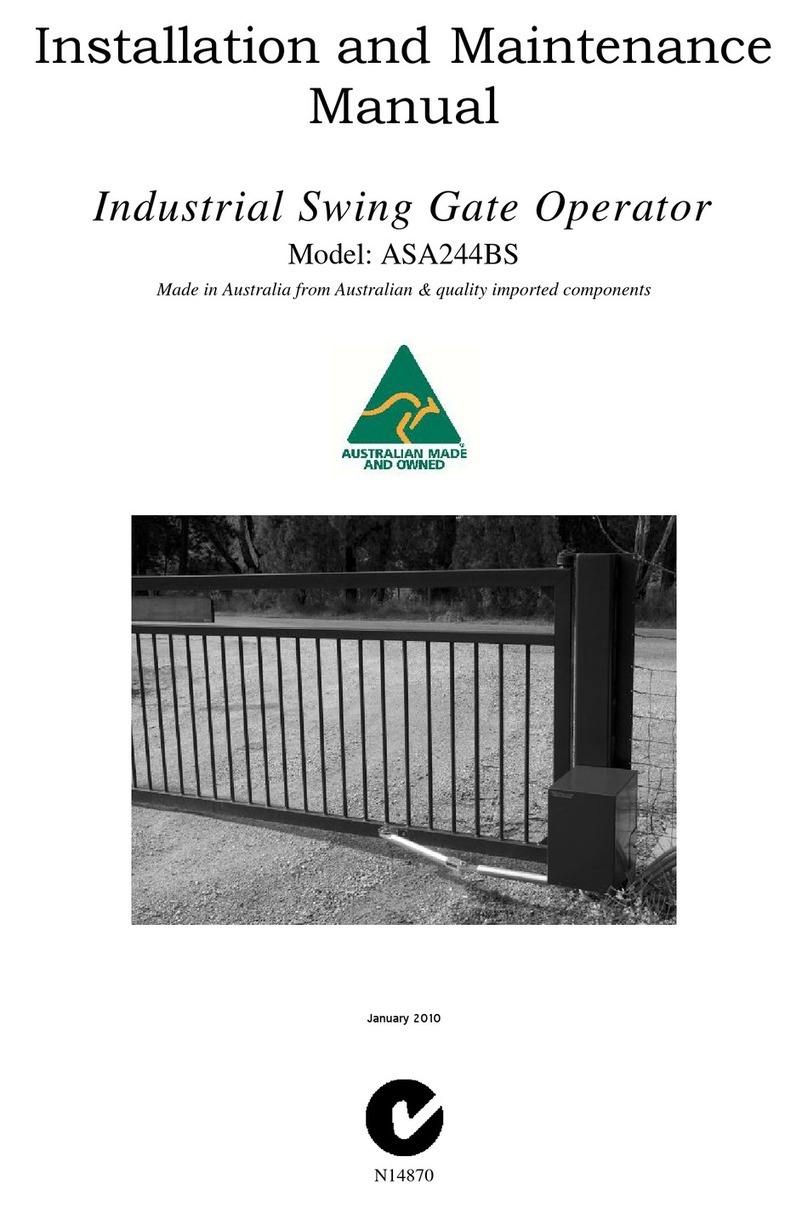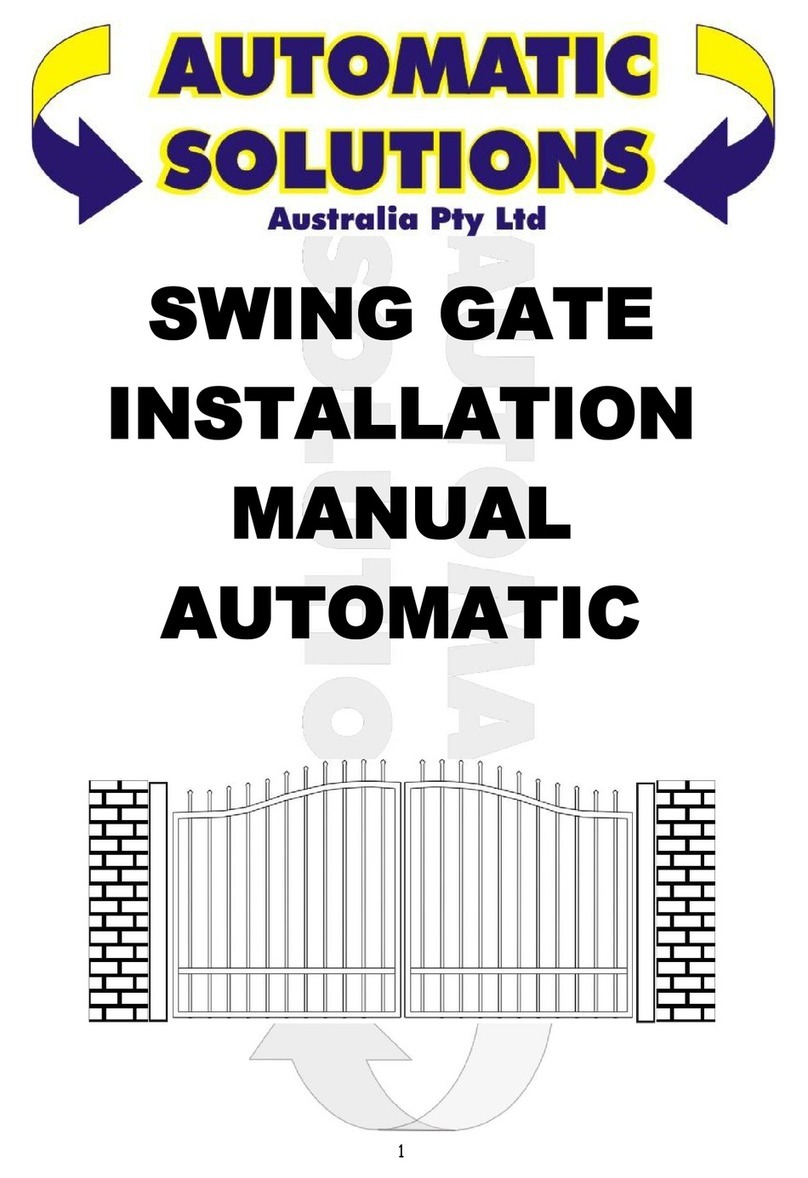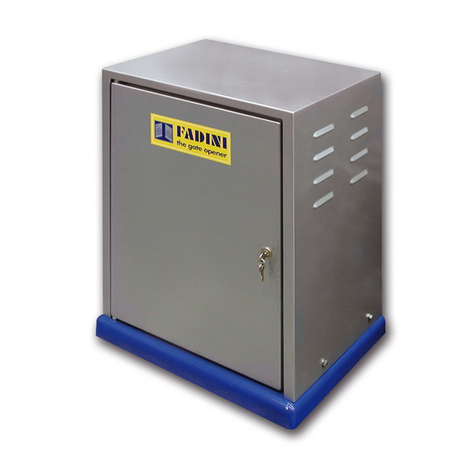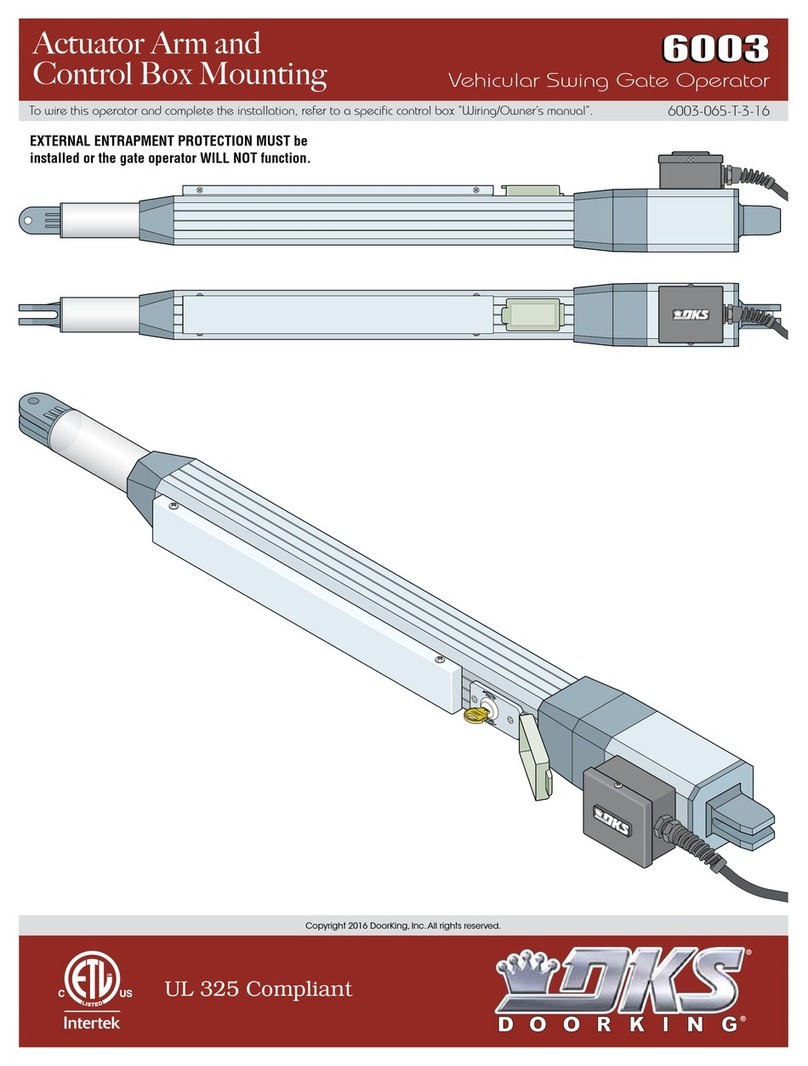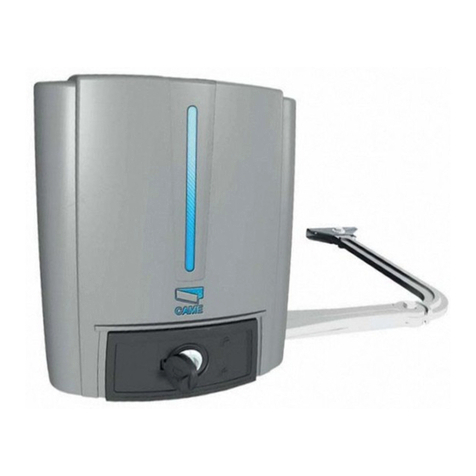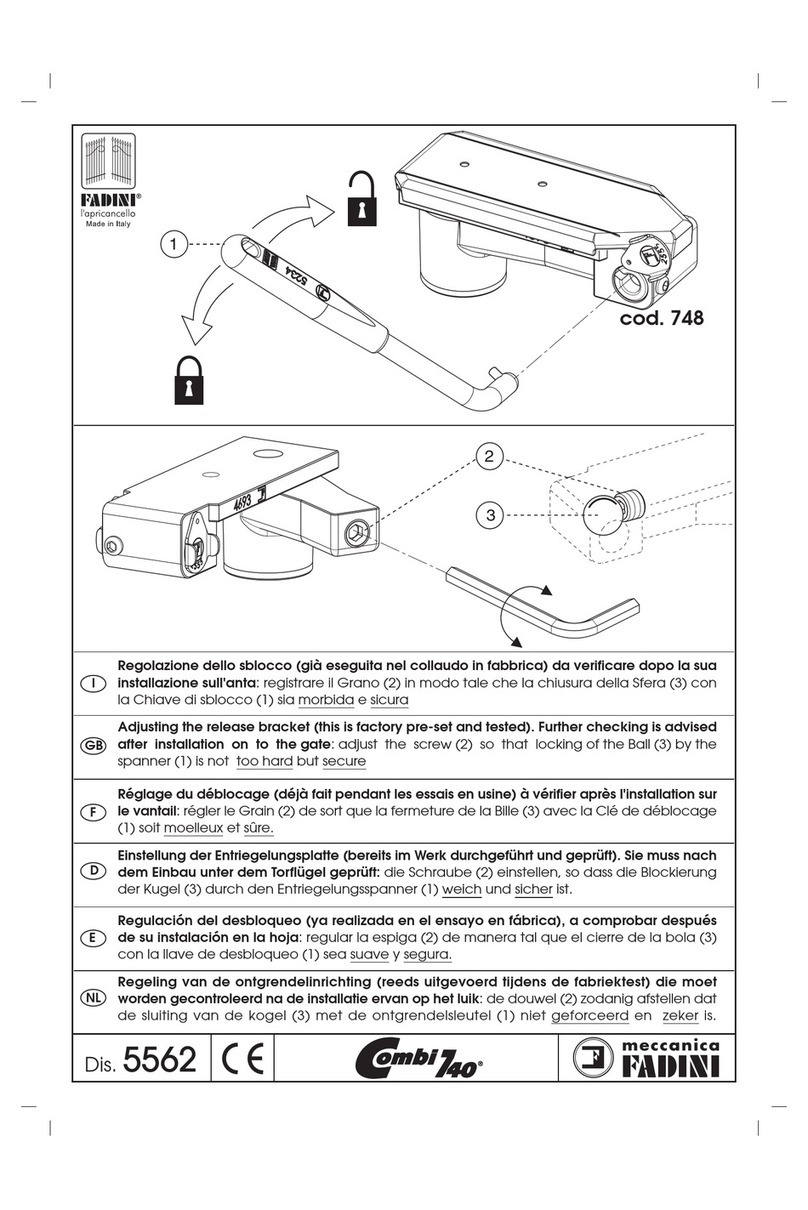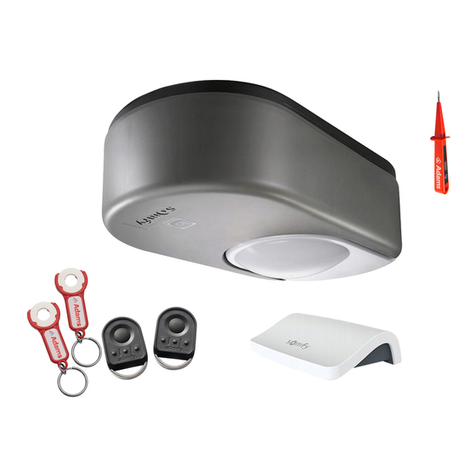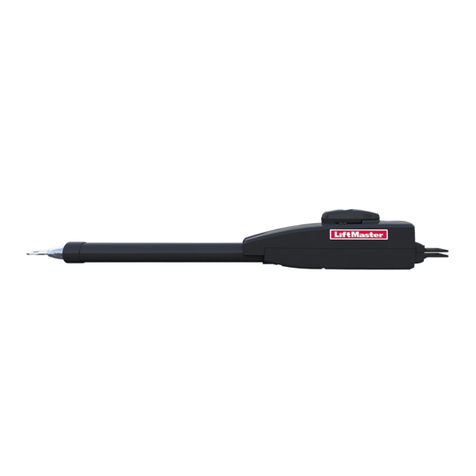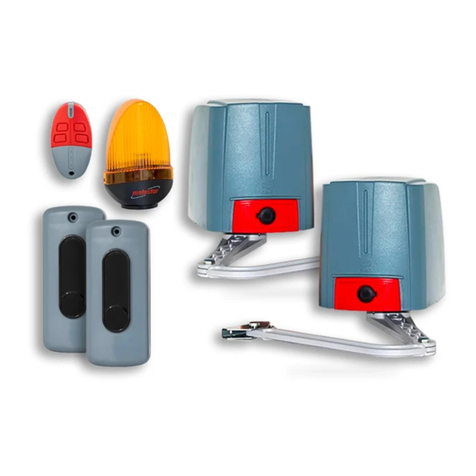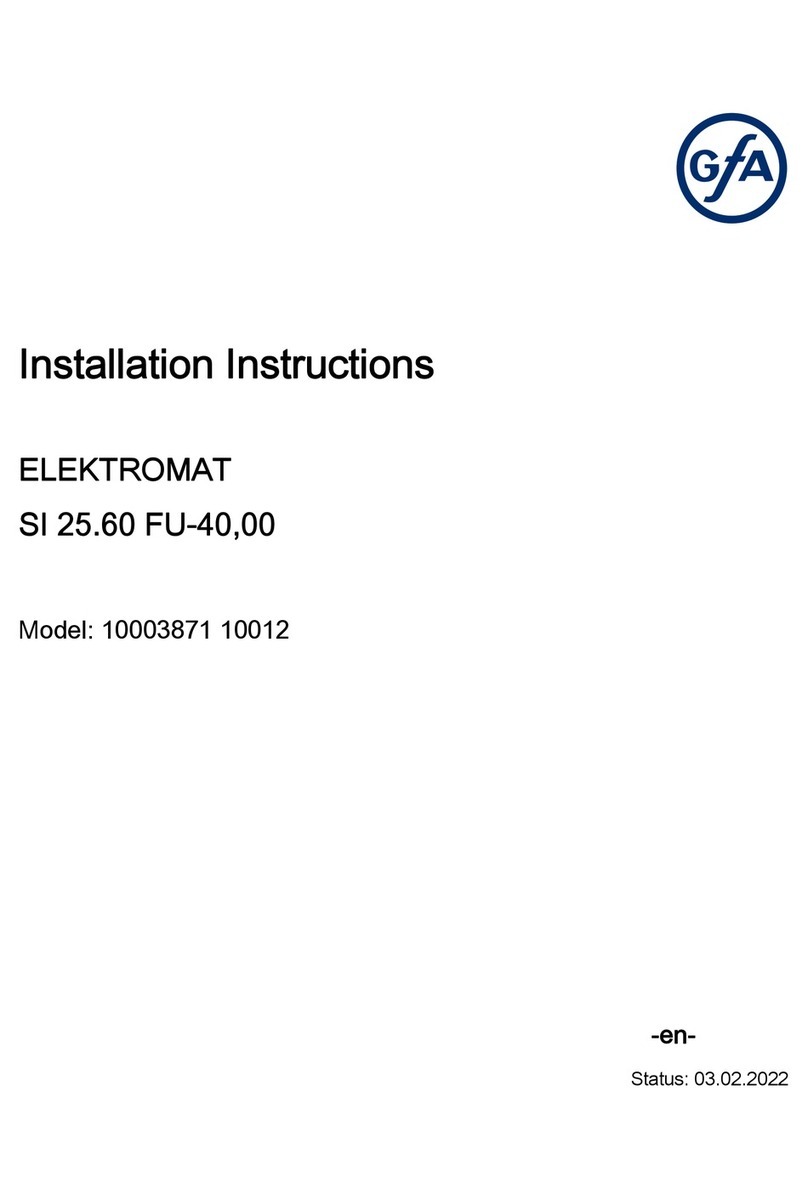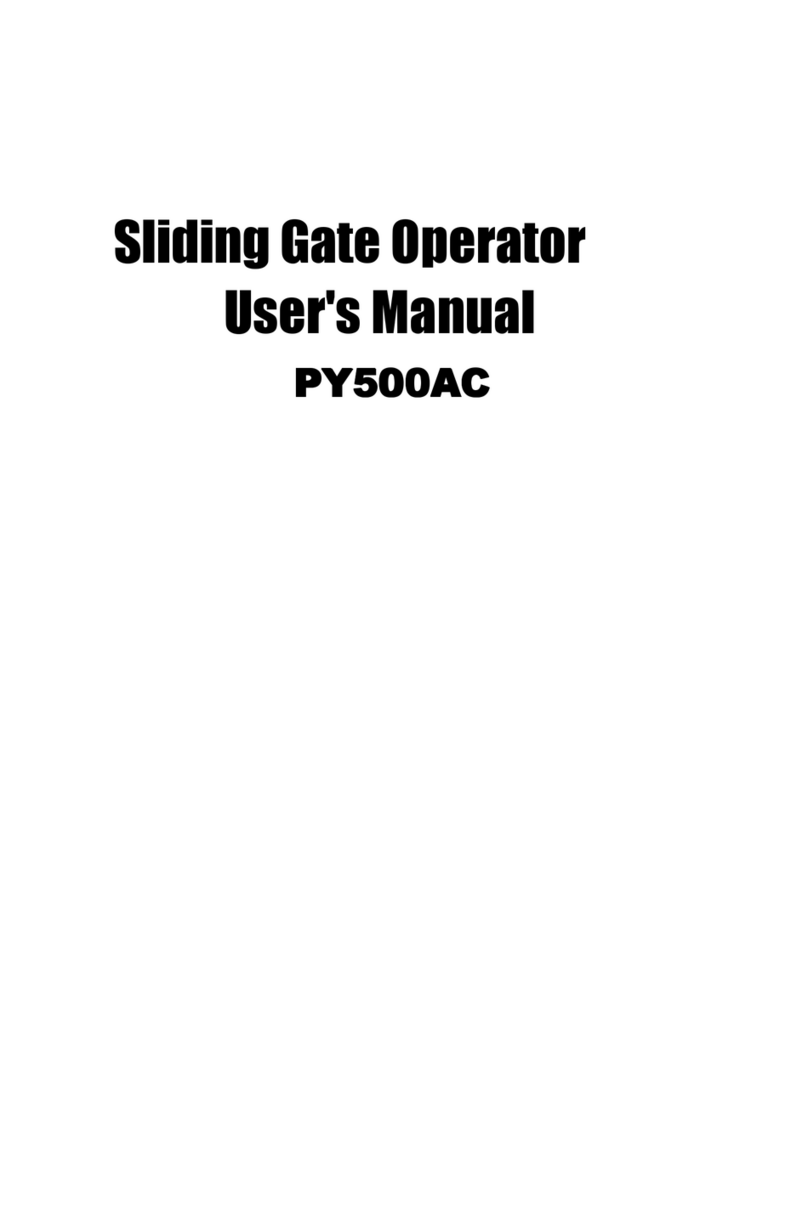Automatic Solutions KING 24V User manual

KING 24V
Operatore
Operateur
Operator
Torantrieb
Operador
Alimentazione
Alimentation
Power Supply
Stromspannung
Alimentacion
Forza max di spinta
Force maxi de poussée
Thrust force
Max. Schubkraft
Fuerza max de empuje
codice
code
code
code
codigo
KING 24V 24Vdc N 1800 AA14028
Peso max cancello
Poids maxi portail
Max gate weight
Max Torgewicht
Peso máx verja
400 kg / 880 lbs
KING 24V L 24Vdc N 1800 AA14029500 kg / 1100 lbs
ITALIANO pag. 05 / FRANÇAIS pag. 16 / ENGLISH page 27 / DEUTSCH pag. 38 / ESPAÑOL pag. 49
OPERATORE IRREVERSIBILE PER CANCELLI A BATTENTE
OPERATEUR IRREVERSIBLE POUR PORTAILS À BATTANT
IRREVERSIBLE OPERATOR FOR LEAF GATES
TORANTRIEBE FÜR FLÜGELTORE
OPERADOR IRREVERSIBLE PARA CANCELAS DE BATIENTE
T2 24V
con / avec / with / mit

27
27
TECHNICAL FEATURES
KING 24V is a irreversible operator suitable for opening gates
with a leaf length of up to 4,5 metres (Fig. 1).
The KING 24V operator use mechanical stoppers, thus avoiding
the need for electrical limit switches.
G
B
SYSTEM LAY-OUT
** With incorporated mechanical stop that cuts in during opening. - If
the mechanical stop is used during closing (optional), the maximum
travel is reduced by 50 mm.
21
2
1
2
Connection
Motor
TECHNICAL DATA
Max. leaf length
Max. leaf weight
Max. travel
Average opening time
Operating speed
Thrust force
EEC Power supply
Motor capacity
Power absorbed
Daily operations suggested
Service
Guaranteed consecutive cycles
Grease
Weight of electroreducer
Noise
Volume
Operating Temperature
Protection
m 3,5* 4,5*
kg 400 500
mm 345** 475**
s. 14÷27 29÷38
m/s. 0,0125
N 1800
24V
W 118
A 5,4
n° 150
90%
n° 200/14s
Bechem - RHUS 550
kg 10 14
db <70
m3 0,0184 0,0211
°C -10 ÷ +55°C
IP 44
KING 24V KING 24V L
Measurements in mm
KING L L=1020 L1=945 L2=470
KING L=888 L1=815 L2=340
1 - KING 24V operator
2 - Tuned aerial
3 - Flashing lamp
4 - Key selector
5 - Photoelectric cells (external)
1
❺
❹
❶❶❺❹
❷❸

28
28
G
BINSTALLATION KING 24V
PRE-INSTALLATION CHECKS
The leaf must be fixed firmily on the hinges to the pillars, must not be
flexible during the movement and must move without frictions.
Before the installation of KING 24V, verify all dimensions etc.
There’s no need for any modification, if the gate is like that shown
in Fig. 1.
Gate features must be uniformed with the standards and laws in
force. The gate can be automated only if it is in a good condition and
its conditions comply with the EN 12604 norm.
- The gate leaf does not have to have a pedestrian opening. In the
opposite case it is necessary to take the appropriate steps, in
accordance with EN 12453 norm (for instance; by preventing the
operation of the motor when the pedestrian opening is opened, by
installing a safety microswitch connected with the control panel).
- No mechanical stop shall be on top of the gate, since mechanical
stops are not safe enough.
FIXING THE ACTUATOR ATTACHMENT TO THE COLUMN
To obtain a correct movement of the leaf gate it is necessary to respect
the measures (to see the TABLES of the measures).
COLUMN ATTACHMENT FOR KING 24V OPERATOR
(code CCA1293 - CCA1294)
If the column is in iron, the attack can be screwed directly using four
metric screws M8.
If the column is in concrete, the attack can be fixed with four expansion
screws Ø 8 mm (Fig. 3).
In the case you have a wall parallel with the open gate, you must
provide a niche in which to place the operator.
COLUMN ATTACHMENT FOR KING 24V L OPERATOR
(code CCA1370 - CCA1319)
To obtain a correct movement of the leaf gate it is necessary to respect
the measures.
If there is an iron pillar you can weld the attachment directly.
If there is a cement pillar, you can use the fixing plate as in Fig. 5 which
is fastened with 4 Fischer-screws of Ø 8 mm.
There is also the possibility to cement the attachment welding an
anchor at its base Fig. 6.
Naturally you have to respect predetermined fixing measures.
Afterwards you must weld the other actuator’s attachment to the gate
(Fig. 8).
In the case you have a wall parallel with the open gate, you must
provide a niche in which to place the operator.
FIXING THE OPERATOR ATTACHMENT TO THE GATE
(to see the TABLES of the measures).
Before inserting the pin into the gate attachment, grease
thoroughly.
Weld the base at the right height (Fig. 8).
Fix the KING 24V and try several times to open and to close the gate,
controlling that the operator does not touch the moving gate.
76
4 5
3
8
COMMAND TYPE USE OF THE SHUTTER
Skilledpersons Skilledpersons Unrestricteduse
(outofpublicarea*) (publicarea)
withmannedoperation A B nonpossibile
withvisibleimpulses CorE CorE CandD,orE
(e.g.sensor)
withnotvisibleimpulses CorE CandD,orE CandD,orE
(e.g.remotecontroldevice)
automatic CandD,orE CandD,orE CandD,orE
*atypicalexamplearethoseshutterswhichdonothaveaccesstoanypublicway
A:Commandbuttonwithmannedoperation(thatis,operatingaslongasactivated),
likecodeACG2013
B:Keyselectorwithmannedoperation,likecodeACG1010
C:Adjustablepowerofthemotor
D:Safetyedges,likecodeACG3010and/orothersafetydevicestokeepthrustforce
withinthelimitsofEN12453regulation-AppendixA.
E:Photocells,likecodeACG8026(Toapplyevery60÷70cmforalltheheightofthe
columnofthegateuptoamaximumof2,5m-EN12445point7.3.2.1)
Parts to install meeting the EN 12453 standard

29
29
G
B
MECHANICAL STOPPER ADJUSTMENT
To adjust the stoppers you have to follow the scheme (Fig. 9).
To set the opening limit it’s enough to fix the stopper (A) in the needed
position by tightening the 8mA screw with a n. 13 key.
To obtain the desired closing limit you must adjust the stopper (B)
(OPTIONAL) ) in the needed position and tighten it as for stopper (A).
EMERGENCY RELEASE
To move the gate manually it is necessary to release the operator
inserting the special key and turning it 2 times in the anti-clockwise
sense (Fig. 11).
In order to carry out the manual operation of the gate leaf the followings
must be checked:
- That the gate is endowed with appropriate handles;
- That these appropriate handles are placed so to avoid safety risks for
the operator;
- That the physical effort necessary to move the gate leaf should not be
higher than 225 N, for doors/gates for private dwellings, and, 390N for
doors/gates for commercial and industrial sites ( values indicated in
5.3.5 of the EN 12453 norm).
MAINTENANCE
To be undertaken only by specialized staff after disconnecting power
supply.
Lubricate the hinges and check the oil level and thrust force generated
by the operator on the gate once a year.
Lubricate the nut screw with silicon grease every two years.
10
9
11
ANT
Leafattachment
KING24V
S1
Z
Y
X
S2
Z Y X
S3
Z Y X
COL
Columnattachment
KING24V
ANTKING24VL
Leafattachment
KING24VL
B
ACD
45
12

30
30
G
B
13
* In the case of leaf longer than 2,5 metres, an electric lock must be fitted to ensure
efficient closing.
If the pillar is too large, and it is not possible to adjust the actuator respecting the measure
(B), you must make a niche in the pillar or you have to move the gate to the edge of the pillar.
ANT
Leafattachment
S1
Z
Y
X
COL
Columnattachment
KING24V
RESPECT THE MEASURES FOR A CORRECT INSTALLATION
MECHANICAL STOP - OPTIONAL
Code ACG8089
Optional mechanical stop to stop closing, if the gate is not fitted with a floor stop (Fig. 14).
RESPECT THE MEASURES WITH 2 MECHANICAL STOPPERS
14
B
A
CD
ANTKING24VL
LeafattachmentKING24VL
S3-Y
S3-X
S1-Z
S2-Y
S2-Y
-
-
S1-Z
S2-Y
S1-Y
-
-
-
COL
1÷1,80
1,81÷2,20
2,21÷2,50
2,51*÷3,00*
3,01*÷3,50*
3,51*÷4,00*
4,01*÷4,50*
90°
45 100 100 815 90 14 A
45 110 110 815 90 18 A
70 140 110 815 90 20 A
90 170 140 815 115 25 B
115 200 140 815 115 27 B
105 190 190 945 150 26 D
160 214 120 945 150 20 D
L
Min.÷Max aA
max
T
sec
B C D E
1÷1,80
1,81÷2,20
2,21÷2,50*
2,51*÷3,00*
3,01*÷3,50*
3,51*÷4,00*
110° 20
90 140 815 90 20 A
100 130 815 90 21 A
110 140 815 115 24 B
130 140 945 120 29 C
160 150 945 120 19 C
160 230 945 150 22 D
L
Min.÷Max aA
max
T
sec
B C D E
ANT
ANT
KING24V
KING24V
KING24V
KING24V
KING24V
KING24VL
KING24VL
KING24V
KING24V
KING24V
KING24VL
KING24VL
KING24VL
COL
S3-Y
S3-X
S1-Z
S1-Y
-
-
COL
COL
S1-Z
S2-Y
S1-Y
-
-
1÷1,80
1,81÷2,20
2,21÷2,50
2,51*÷3,00*
3,01*÷3,50*
3,51*÷4,00*
90°
45 100 100 775 90 14 A
45 110 110 775 90 18 A
70 140 110 775 115 20 B
70 160 140 775 115 25 B
60 170 170 905 120 23 C
100 190 180 905 120 25 C
L
Min.÷Max aA
max
T
sec
B C D E ANT
ANT
1÷1,80
1,81÷2,20
2,21÷2,50*
2,51*÷3,00*
3,01*÷3,50*
110° 20
90 140 775 90 20 A
100 130 775 90 21 A
110 140 775 115 24 B
130 140 905 120 18 C
130 150 905 120 19 C
L
Min.÷Max aA
max
T
sec
B C D E
KING24V
KING24V
KING24V
KING24V
KING24VL
KING24VL
KING24V
KING24V
KING24V
KING24VL
KING24VL

31
31
G
B
ELECTRIC CONNECTIONS T2 24V code BC07088
T2 24V CRX code BC07089
ANTENNA
ANTENNA
BRAIDING
CLOSE
OPEN
STOP
FUSE
T 2 A
PHOTOCELLS
STEP BY STEP
COMMON
COMMON
24Vdc 0,8A ± 15% for ACCESSORY SUPPLY
24Vdc 0,8A ± 15% for AUTOTEST SAFETY STRIPS BLINKER
24Vdc 20W
LED R=2,2K 1/4W
ELECTRIC
LOCK
PEDESTRIAN
SAFETY STRIPS
POWER SUPPLY
230Vac 50 Hz
TRANSFORMER
M1
M2

32
32
G
B
Power supply 230 Vac 50/60 Hz - external to
the control panel - (120V/60Hz upon request)
Common contact
Closing impulse contact (NA)
Opening impulse contact (NA)
STOP impulse contact (NC)
Radio Antenna
Gate open state and battery state output
indicator (24Vdc 3W max)
+ 24Vdc safety strip self-test power supply
Safety strip contact (NC)
Common contact
Photocells contact (NC)
Single pulse contact (NO)
Pedestrian opening contact (NA)
+ 24Vdc accessories power supply
- 24Vdc accessories power supply
Electric lock connection (MAX 15W 12V)
- 24Vdc blinker (code ACG7061) power
supply. Pay attention to the polarity.
Connection to secondary coil of transformer
18 Vac
MOTOR 1 CONNECTION (without polarity)
MOTOR 2 CONNECTION (without polarity)
Connector dedicated to the factory
programming.
DO NOT REMOVE ANY JUMPER!
OTHERWISE THE OPERATOR WILL NOT
WORK!
Connector dedicated to the factory
programming (only CRX control board)
DO NOT REMOVE ANY JUMPER!
OTHERWISE THE OPERATOR WILL NOT
WORK!
Built-in radio module (model CRX), or
connector for radio receiver RIB, 24 Vdc
supply
Connector for charge card of 24Vdc battery
(code ACG4648)
Trimmer for high speed adjustment operations
Trimmer for low speed adjustment operations
Trimmer for automatic closing time adjustment
(DISABLED DEFAULT AND DL6 LED OFF)
Programming button
Motor protection fuse
Transformer protection fuse
J1
J2
J3
J4
J5
J6
J7
J8
J9
J10
TR1
TR2
TR3
S3
FUSE 1
F1
N F
COM.
CLOSE
OPEN
STOP
AERIAL
SIGNAL
A+TEST
EDGE N.C.
COM.
PHOTO N.C.
K BUTT.
PED. BUTT.
A+
A -
LOCK
SECONDARY
TRANSFORMER
MOTOR 1
MOTOR 2
SW T2 24V
SW RADIO
RADIO
BATTERY
CHARGER
TRIMMER RUN
TRIMMER
LOW SPEED
TRIMMER TCA
PROG
T 8 A
T 2 A
J3
TR2TR1
J2
J4
F1
FUSE 1
J5
J6
TR3
J10
J8
J9
J1
J7
S3
A - CONTROL PANEL FEATURES
TRANSFORMER

33
33
G
B
B - SETTINGS
DIP 1 (ON) - MOTOR ROTATION DIRECTION CONTROL (POINT C)
DIP 2 (ON) - TIMER (POINT D)
DIP 3 (ON) - ACTIVATES DOOR RELEASE DURING PHASES OF
SLOWDOWN AND TOTAL OPENING AND CLOSING (AS PER THE
IMPACT TESTS OF EN12453)
DIP 1-2 MEMORIZATION/CANCELLATION OF RADIO CONTROL CODES FOR
TOTAL OPENING (ONLY MODEL CRX) (POINT E)
DIP 1-3 MEMORIZATION/CANCELLATION OF RADIO CONTROL CODES FOR
PEDESTRIAN OPENING (ONLY MODEL CRX) (POINT F)
DIP 2-1 MICRO-SWITCH CONTROLLER FOR PEDESTRIAN OPENING TIMER
DIP 4 Photocells always active (OFF) - Photocells active only during closing
(ON)
DIP 5 Pre-blinking (ON) - Normal blinking (OFF)
DIP 6 Single pulse command (K BUTT) and step-by-step radio receiver (OFF) -
automatic (ON)
DIP 7 Power sensor operation (ON-activated) time operation (OFF-activated).
DIP 8 Electric lock activation (ON-activated)
DIP 9 Electric lock pulse release (ON-activated)
DIP 10 Electric lock pulse engagement (ON-activated)
DIP 11 Easy release activation (ON-activated)
DIP 12 Sensor TEST activation (ON-activated).
DIP 13 Selection of 1 or 2 motor operation (default OFF 2 motors)
DIP 14 KING 24 - ON
DIP 15 KING 24 - OFF
DIP 16 IMMEDIATE CLOSING AFTER PASSING IN FRONT OF PHOTOCELLS
ON ACTIVATED
OFF DEACTIVATED
JP1 => Check that the jumper is inserted!
JP2 => Check that the jumper is inserted!
JP3 => Check that the jumper is inserted!
PROG => S3 Programming button
ADJUSTMENTS
ATTENTION: PUT DIP 3 IN THE ON MODE ONLY AFTER HAVING CARRIED
OUT ALL THE PROGRAMMING PROCEDURES.
NOTE: WITH DIP 3 (ON) BRIEF GATE REVERSAL AFTER IMPACT IS
ACTIVATED.
THIS BRIEF GATE REVERSAL PERMITS STATIC FORCE TO BE REDUCED
TO ZERO WITHIN 5 SECONDS AS PER STANDARD EN12453 POINT A.2.2
(ACCEPTABLE STATIC FORCE), THEREBY COMPLYING WITH THE IMPACT
TESTS ALSO OUTLINED BY EN12453).
IF COMPLIANCE WITH THE AFOREMENTIONED STANDARD IS
UNNECESSARY, SIMPLY POSITION DIP 3 TO OFF. IN THIS CASE THE GATES
STOP WITHOUT REVERSING.
RUN TRIMMER (TR1) high-speed electronic regulator
This trimmer permits motor speed adjustment (the default setting is maximum
speed). Adjustment of the automation is useful for compliance with European impact
standards.
LOW-SPEED TRIMMER (TR2) Electronic slow speed approach control
The slow speed control is performed by adjusting the LOW- SPEED TRIMMER
which changes the voltage output across the motor(s) (turning it clockwise increases
the speed). Adjustment is performed to determine the correct speed at the end of
opening and closing according to the gate or when there is friction that might cause
the system to function poorly.
AUTOMATIC CLOSING TRIMMER - TCA (TR3) TOTAL OR PEDESTRIAN
default NOT ACTIVATED and LED DL6 OFF (TRIMMER FULLY ROTATED
COUNTERCLOCKWISE)
This trimmer makes it possible to adjust the time for total or pedestrian automatic
closing. Only with gate completely (total) or partially (pedestrian) open and LED DL6
on (trimmer rotated clockwise).
The pause time can be adjusted from a minimum of two seconds up to a maximum
of two minutes.
LED SIGNALS
DL1 program activated (red)
DL2 gate opening M2 (green)
DL3 gate closing M2 (red)
DL4 gate opening M1 (green)
DL5 gate closing M1 (red)
DL6 automatic closing indicator (red)
DL7 photocell contact (NC) (red)
DL8 sensor contact (NC) (red)
DL9 STOP button (NC) (red)
DL10 radio code program (green)
FUSES
Fuse 1 T 8A MOTOR PROTECTION FUSE
F1 T 2A TRANSFORMER PROTECTION FUSE (on the outside of the T2 24V
board)
C - MOTOR ROTATIONAL DIRECTION CONTROL
1 - Set DIP 1 to ON => LED DL1 starts flashing.
2 - Press and hold the PROG button. (movement is now manually controlled - open-
stop-close-stop-open - etc.) => GREEN LEDS DL2 and DL4 are lit and the gate
panels open with a fixed lag of 2 sec. If they close instead of open, release the
button and reverse the two wires on the motor used.
3 - After opening release the PROG button and calibrate the mechanical opening
stops (on the operator).
4 - Press and hold the PROG button => RED LEDs DL3 and DL5 turn on and the
gate panels close with a time lag of 2 sec.
5 - Continue to hold the PROG button until the gate is completely closed.
6 - Leave the two doors completely closed to set the timer.
7 - Reset DIP1 to OFF => LED DL1 turns off, signaling exit from control.
N.B.: During this check the stop, the photocells and the sensors are not active.
D - SETTING THE TIMER FOR 2 MOTORS (#) WITH POWER
SENSOR ACTIVATED (DIP 7 ON)
WHILE SETTING THE TIMER THE POWER SENSOR IS CONTINUOUSLY
ACTIVATED.
1 - The gate must be completely closed.
2 - Set DIP 2 to ON => LED DL1 will blink rapidly.
3 - Press the PROG button. => M1 opens.
4 - When the mechanical opening stop is reached, the AUTOMATIC POWER
SENSOR stops M1 (memorizing the time and the power) => At the same time
M2 is triggered to open.
5 - When the mechanical opening stop is reached, the AUTOMATIC POWER
SENSOR stops M2 (memorizing the time and the power).
6 - Press the PROG button. => M2 closes.
7 - Press the PROG button. => M1 closes and sets the lag time between M2 and M1.
At the same time LED DL1 stops flashing indicating exit from the programming
procedure.
Safety and other gate commands now operate normally (inversions, stop,
alarms, etc.).
8 - The gate panels will close in high-speed mode (depending on how you set the
RUN trimmer) and near total closure in the slow mode (depending on how you
set the LOW-SPEED trimmer).
9 - Upon closing the power sensors stop the gate.
10 - AFTER PROGRAMMING RESET DIP 2 TO OFF.
D - SETTING THE TIME FOR ONE MOTOR (M1) (#) WITH POWER
SENSOR ACTIVATED (DIP 7 ON)
CAUTION: FOR ONE MOTOR CONTROL DIP 13 MUST BE POSITIONED TO ON;
DURING PROGRAMMING THE POWER SENSOR IS CONTINUOUSLY ACTIVE.
The gate must be completely closed.
1 - Set DIP 2 to ON => LED DL1 will blink rapidly.
2 - Press the PROG button. => M1 opens.
When the mechanical opening stop is reached, the AUTOMATIC POWER
SENSOR stops M1 (memorizing the time and the power).
3 - Press the PROG button. => M1 closes.
At the same time LED DL1 stops flashing indicating exit from programming.
Safety and other gate commands now operate normally (inversions, stop,
alarms, etc.).
Upon closing the power sensor stops the gate.
4 - AFTER PROGRAMMING RESET DIP 2 TO OFF.
(#) DURING PROGRAMMING THE SAFETY DEVICES ARE ACTIVE AND STOP
THE PROGRAMMING PROCEDURE (LED DL1 FROM FLASHING BECOMES
CONSTANT). TO REPEAT PROGRAMMING SET DIP 2 TO OFF, CLOSE
THE GATE USING THE PROCEDURE “MOTOR ROTATIONAL DIRECTION
CONTROL” AND REPEAT THE DESIRED PROGRAMMING PROCEDURE.

34
34
G
B
D - SETTING THE TIME FOR 2 MOTORS (#) WITH TIME OPERATION
(DIP 7 OFF)
1 - The gate must be completely closed.
2 - Set DIP 2 to ON => LED DL1 will blink rapidly.
3 - Press the PROG button. => M1 opens.
4 - When the mechanical opening stop is reached, wait a second then press the
PROG button => M1 stops and M2 opens.
5 - When the mechanical opening stop is reached => wait 1 second and press the
PROG button => M2 stops.
6 - Press the PROG button => M2 closes.
7 - Press the PROG button => M1 closes setting the time lag between M2 and M1.
At the same time LED DL1 stops flashing indicating exit from the programming
procedure.
Safety and other gate commands now operate normally (inversions, stop,
alarms, etc.).
8 - After the set amount of time, the gate will stop.
9 - AT THE END OF PROGRAMMING RESET DIP 2 TO OFF.
NOTE: The slowdown is automatically determined by the control board during
the time setting phase and is activated at about 50 to 60 cm before reaching the
mechanical opening or closing limit.
D - SETTING THE TIME FOR 1 MOTOR (#) WITH TIME OPERATION
(DIP 7 OFF)
CAUTION: FOR ONE MOTOR CONTROL DIP 13 MUST SET TO ON
1 - The gate must be completely closed.
2 - Set micro-switch DIP 2 to ON => LED DL1 will blink rapidly.
3 - Press the PROG button => M1 opens.
4 - When the mechanical opening stop is reached, wait a second then press the
PROG button => M1 stops.
5 - Press the PROG button => M1 closes.
At the same time LED DL1 stops flashing indicating exit from the programming
procedure.
Safety and other gate commands now operate normally (inversions, stop,
alarms, etc.).
6 - After the set amount of time, the gate will stop.
7 - AT THE END OF PROGRAMMING RESET DIP 2 TO OFF.
D - SETTING PEDESTRIAN OPENING TIMES (#) BOTH FOR TIME AND
POWER SENSOR OPERATION
With gate closed:
1 - First set DIP2 to ON (LED DL1 flashes quickly) and then DIP1 to ON ( LED DL1
flashes slowly).
2 - Push the pedestrian button (COM-PED.BUTT) => M1 opens.
3 - Push the pedestrian button to stop movement (thereby setting M1 opening).
4 - Push the pedestrian button to start closing.
5 - Upon closing reset DIP 1 and 2 to OFF.
(#) DURING PROGRAMMING THE SAFETY DEVICES ARE ACTIVE AND STOP
THE PROGRAMMING PROCEDURE (LED DL1 FROM FLASHING BECOMES
CONSTANT).
TO REPEAT PROGRAMMING SET DIP 2 TO OFF, CLOSE THE GATE USING
THE PROCEDURE “MOTOR ROTATIONAL DIRECTION CONTROL” AND
REPEAT THE DESIRED PROGRAMMING PROCEDURE.
E - RADIO CODE PROGRAMMING FOR TOTAL OPENING
(UP TO 62 CODES - CRX MODELS ONLY)
Programming can be done only when the gate is stationary.
1 - First set DIP 1 to ON and then DIP 2 to ON.
2 - The red LED DL1 flashes ON every 1 sec. and OFF for 10 seconds.
3 - Press the remote control button (usually channel A) within the allotted 10
seconds. If the remote is memorized properly LED DL10 (green) blinks.
4 - The programming time for codes is automatically renewed in order to memorize
the next remote control.
5 - To finish programming, wait 10 seconds, or press the PROG button briefly. The
red LED DL1 stops flashing.
6 - Reset DIP 1 to OFF and DIP 2 to OFF.
7 - End of procedure.
CANCELLATION OF ALL RADIO CODES FOR TOTAL OPENING
Cancellations can only be performed when gate is stationary.
1 - Set DIP 1 to ON and then DIP 2 to ON.
2 - The red LED DL1 flashes ON every 1 second and OFF for 10 seconds.
3 - Press and hold the PROG button for 5 seconds. Memory cancellation is indicated
by two flashes of green LED DL10.
4 - The red LED DL1 remains active and you can add new codes as shown above.
5 - Reset DIP 1 to OFF and DIP 2 to OFF.
6 - End of procedure.
INDICATOR MEMORY FULL OF RADIO CODES FOR TOTAL OPENING
Indication only when gate is stationary.
1 - Set DIP 1 to ON and then DIP 2 to ON.
2 - The green LED DL10 flashes 6 times when the memory is full (62 codes).
3 - LED DL1 will then remain active for 10 seconds enabling possible cancellation
of codes.
4 - Reset DIP 1 to OFF and DIP 2 to OFF.
5 - End of procedure.
F - PROGRAMMING PEDESTRIAN OPENING RADIO CODES
(UP TO 62 CODES - CRX MODELS ONLY)
Programming can be done only when the gate is stationary.
1 - Set DIP 1 to ON and then DIP 3 to ON.
2 - The red led DL1 flashes ON for 1 second and OFF for 1 second for 10 seconds.
3 - Press the remote control button (usually channel B) within the allotted 10
seconds. If the remote is properly memorized LED DL10 (green) blinks.
4 - The programming time for codes is automatically renewed in order to memorize
the next remote control.
5 - To finish programming wait 10 seconds, or press the PROG button briefly. The
red LED DL1 stops flashing.
6 - Reset DIP 1 to OFF and DIP 3 to OFF.
NOTE: If LED DL1 CONTINUES BLINKING QUICKLY IT MEANS THAT DIP 1
IS STILL SET TO ON AND THAT ANY OPERATION IS REFUSED.
7 - End of procedure.
CANCELLATION PROCEDURE FOR ALL PEDESTRIAN OPENING RADIO
CODES
Cancellation can only be performed when the gate is stationary.
1 - Set DIP 1 to ON and then DIP 3 to ON.
2 - The red LED DL1 flashes ON for 1 second and OFF for 1 second for 10 seconds.
3 - Press and hold the PROG button for 5 seconds. Memory cancellation is indicated
by two flashes of green LED DL10.
4 - The red LED DL1 remains active and you can add new codes as shown above.
5 - Reset DIP 1 to OFF and DIP 3 to OFF.
6 - End of procedure.
INDICATION MEMORY FULL OF PEDESTRIAN OPENING RADIO CODES
Indication only when the gate is stationary.
1 - Set DIP 1 to ON and then DIP 3 to ON.
2 - The green LED DL10 flashes 6 times when the memory is full (62 codes).
3 - The LED DL1 will then remain active for 10 seconds enabling possible
cancellation of codes.
4 - Set DIP 1 to OFF and DIP 3 to OFF.
5 - End of procedure.
CONTROL ACCESSORIES OPERATION
ATTENTION: ONLY IMPULSIVE COMMANDS HAVE TO BE CONNECTED.
Make sure that any other type of command accessories (e.g. mass detectors)
used on the installation are set in the IMPULSIVE mode, otherwise, the gate
will be operated even without the protection of the safety devices.
STEP-BY-STEP BUTTON (COM-K BUTTON)
If DIP6 ON => It cyclically performs the commands open-stop-close-stop-open
etc.
If DIP6 OFF => Opens the gate when closed. There is no effect if activated
while opening. If activated when gate is open, the gate closes. If
activated while closing, the gate reopens.
OPEN BUTTON (COM-OPEN)
The button controls the opening movement when the gate is stationary. If activated
while closing, it reopens the gate.
CLOCK FUNCTION OF OPEN BUTTON
If you want the Clock Function must request T2 24V with firmware 02.
ATTENTION: A CLOCK CONNECTED TO T2 24V with fw 03 or more
ACTIVATES THE OPENING MOVEMENT OF THE GATE WITHOUT HAVING
THE PROTECTION OF THE SAFETY DEVICES!
This function is useful during peak hours, when vehicle traffic is slow (e.g. entry/
exit of workers, emergencies in parking or residential areas and, temporarily, for
moving operations).

35
35
G
B
CLOCK FUNCTION APPLICATION
It is necessary to request a T2 24V control panel with firmware 02.
By connecting a switch and/or a daily/weekly clock (instead of or in parallel to the
open button N.O. “COM-OPEN”), you can open and keep the automation open for
as long as the switch is pressed or the clock remains active. Command functions
are inoperative with open automation.
Releasing the switch or at the preset time, the automation closes immediately.
CLOSE BUTTON (COM-CLOSE)
Controls the closing movement when the gate is stationary.
REMOTE CONTROL
If DIP6 ON => It cyclically performs the commands open-stop-close-stop-open
etc.
If DIP6 OFF => Opens the gate when closed. There is no effect if activated
while opening. If activated when gate is open, the gate closes. If
activated while closing, the gate reopens.
PEDESTRIAN OPEN BUTTON (COM-PED.BUTT.)
Partial opening and closing control.
During pedestrian opening, pausing or closing, you can control the opening of any
command linked to the T2 24V board.
With DIP 6 you can choose the operation mode of the pedestrian push button.
If DIP6 ON => It cyclically performs the commands open-stop-close-stop-open
etc.
If DIP6 OFF => Opens the gate when closed. There is no effect if activated
while opening. If activated when gate is open, the gate closes. If
activated while closing, the gate reopens.
ELECTRIC LOCK (LOCK)
Set DIP 8 to ON to enable control of the electric lock when opening.
ELECTRIC LOCK PULSE RELEASE IN OPENING
Set DIP 9 to ON to enable the electric lock pulse release when opening (provided
DIP 8 is ON).
If a command to open the gate is given when the gate is closed, the closing
movement is performed for 0.5 seconds and the electric lock is simultaneously
activated (followed by a 0.5 second pause and then the opening of the gate).
ELECTRIC LOCK PULSE ENGAGEMENT
Set DIP 10 to ON to enable the pulse engagement of the electric lock when closing.
Upon closing, motors are activated for 0.5 seconds at full voltage to ensure lock
engagement.
EASY MOTOR RELEASE
Set DIP 11 to ON to enable easy manual release (provided that DIP 10 is ON),
upon closing a reverse motion with a fixed time of 0.2 seconds occurs to facilitate
manual release.
OPERATION OF SAFETY ACCESSORIES
PHOTOCELL (COM-PHOT)
DIP 4 OFF => if an obstacle is placed in range of the photocells when the gate is
closed, the gate does not open. During operation, photocells work
when opening (by starting the opening movement only after the
obstacle is removed) and closing (by starting the reverse movement
only after the obstacle is removed).
DIP 4 ON => if an obstacle is placed in range of the photocells when the gate
is closed and the command to open is given, the gate opens (the
photocells do not work while opening). Photocells work only during
closing (with reverse motion restored after a second, even if they are
still engaged).
CONTROL OF IMMEDIATE CLOSING AFTER MOVEMENT IN FRONT OF
PHOTOCELLS
DIP 16 ON and DIP 4 OFF => if photocells are engaged during opening, the gate
stops and the gate only closes one second after the
photocells are disengaged.
DIP 16 ON and DIP 4 ON => if photocells are engaged during opening, the gate
continues to open. Upon disengagement of the
photocells, the gate stops and reverses closing
motion after a one second pause.
If total opening is reached (end of opening time),
immediate closing is deactivated and automatic
time closing is activated (if TCA trimmer is
activated and LED DL6 is on). If during closing
there is a rapid movement (e.g. pedestrian) the
gate will open again for two seconds and then
close once again.
DIP 12 OFF => immediate closing after movement in front of the
photocells is deactivated.
N.B.: Please check photocell operation at least every six months.
EDGE (SAFETY STRIP) (COM-EDGE)
If engaged during opening, reverses the motion when closing.
If engaged when closing, reverses the motion when opening.
If it remains engaged again, it performs a further reversal after 2 seconds, then
performs an additional short reversal and then gives the sensor failure or engaged
alarm (N.O. contact).
If the sensor remains engaged (N.O. contact) no movement is allowed.
If not used, jump the terminals COM-EDGE.
MONITORING OF SAFETY SENSORS (A+ TEST A-)
Sensors can be monitored through the A+ TEST input and DIP 12 ON.
The monitoring consists of a functional test of the sensor run after every full gate
opening.
Closing the gate is therefore permitted only if the sensors have passed the functional
test after each opening.
CAUTION: MONITORING OF THE SENSOR INPUT CAN BE ACTIVATED WITH
DIP 12 ON OR DEACTIVATED WITH DIP 12 OFF. IN FACT, THE FUNCTIONAL
TESTING OF SENSORS IS ‘POSSIBLE ONLY IF THESE DEVICES HAVE THEIR
OWN POWER SUPPLY.
A MECHANICAL SENSOR CAN NOT BE MONITORED, SO DIP 12 SHOULD BE
SET TO OFF.
SENSOR AUTOTEST ALARM (DIP 12 ON)
If the sensor fails the monitoring test after opening, an alarm is displayed by the
blinker lighting up. Gate closure is not allowed in this condition. Normal operation
can be restored only by repairing the sensor and pressing one of the activated
controls.
STOP BUTTON (COM-STOP)
The STOP button stops the gate during any operation.
If held when the gate is fully open (or partially when using the pedestrian control)
automatic closing is temporarily deactivated (if activated by the TCA trimmer and
LED DL6 on). It is therefore necessary to use a new command to make it close.
The automatic closing function is reactivated on the next cycle (if activated by the
TCA trimmer and LED DL6 on).
POWER SENSOR ALARM
The T2 24V control panel has automatic sensors that make the movement of the
gate reverse in case of impact against objects or persons in accordance with the
current EN standards (always use the right tool to ensure compliance with the values
imposed by the standard), without special adjustments on the control panel, as it
operates using special internal software.
If the power sensor is used in opening or closing (only in high-speed) and then
again, in the opposite direction, the gate stops and then reverses for 1 second.
The alarm status will be displayed by the blinker which will remain active for one
minute, during which time you can restore gate operation by pressing any command
button.
FUNCTIONING IN DEAD MAN MODE WHEN THE SAFETY DEVICES ARE
FAILING
If the safety edge fails or remains engaged for more than 5 seconds, or if photocell
fails or remain engaded for more than 60 seconds, the open, close, k button and
pedestrian commands will work only in dead man mode.
The signal that this mode has been activated is given by the blinking of the
programming led.
With the blinking of the programming led, the opening and closing operation are
allowed only with the command button pressed and held. The radio commands
and that of automatic closing, will be excluded, since their use in this mode, is not
allowed by the norms.
Once the failing safety device is repaired, in automatic after 1 second, all standard
commands that were selected, such as step by step, automatic mode, radio
commands and automatic closing start functioning again.
Note 1: during this functioning in dead man mode, in case of damage to the safety
strips (or photocells) the photocells (or safety strips) still work by interrupting
the operation in progress.
Note 2: the stop command is not to be considered a safety command that can be
bypassed in this mode. Therefore, when pressed or damaged, it will not
allow any movement of the gate.

36
36
G
B
The dead-man operation is only an emergency operation which must be
activated for a very short period and with the complete installation at sight so
to have a secure and safe control of the system. As soon as possible however,
the failing safety devices must be repaired and activated.
BLINKER
N.B.: This control panel can power ONLY BLINKERS ON A (ACG7061) CIRCUIT
with lamps up to 24V and 20W.
PRE-BLINKING
DIP 5 - OFF => the motor and blinker begin simultaneously.
DIP 5 - ON => the blinker begins 3 seconds before the motor.
GATE OPEN WARNING LIGHT (COM-SIGNAL)
Signals when the gate is open, partially open or not closed completely. Turns off only
when the gate is completely closed.
This signal is active during programming.
N.B.: Max 3 W. If push buttons or lamps are in excess, the control panel processes
will be endangered and possibly halt operation.
OPERATION AFTER A BLACK-OUT (WITHOUT BATTERIES)
When the power supply comes back the DL1 led turns on and remains on for all
the time the gate stays open. The led will turn off only once the gate is completely
closed.
It is recommended to fully open the gate. Let the gate close by itself or with automatic
closing, or wait until the blinker stops flashing before commanding it to close.
This will allow the gate to realign. If, motors were released and moved from the
normal position when closed during the blackout, the first movement after power
returns must be complete.
If the black out occurs when the gate is still moving or when the gate is open and the
first command sent after the black out is a closing command, the closing of the gate
will be carried out with a total delay between the two gate leaves. Therefore, first
the leaf M2 will close completely; once it is off, M1 will start closing. This separate
movement of the two gate leaves is done to avoid their incorrect overlapping.
TECHNICAL SPECIFICATIONS
- Temperature range 0 ÷ 55°C
- Humidity <95% without condensation
- Voltage 230V~ ± 10%
(120V/60Hz upon request)
- Frequency 50/60 Hz
- Battery power 20-24Vdc
- Transformer Power 130VA -
primary 230Vac
secondary 18Vac
- Maximum absorption 50 mA
- Network Micro-switches 100ms
- Maximum power gate open indicator 24Vdc 3W (equivalent to one
3W or 5 LED light bulb with
resistor in series at 2.2 K ohm)
- Maximum blinker power 24Vdc 20W
- Power available for photocells and accessories 1A ± 15%
- Power available for radio connector 200Ma
RADIO SPECIFICATIONS (model T2 24V CRX)
- Receiving Frequency 433,92 MHz
- Impedance 52 OHM
- Sensitivity >2,24µV
- Pick-up time 300ms
- Drop time 300ms
- All inputs must be used as clean contacts because the power is generated
internally (secure power) to the board and is set up to ensure compliance with
double or reinforced insulation with regard to dangerous voltage.
- Any external circuits connected to the outputs of the control panel must be made
in such a manner as to ensure compliance with double or reinforced insulation with
regard to dangerous voltage.
- All inputs are controlled by a programmed integrated circuit that performs a self
check every time it starts operating.
After having carried out the various connections and having supplied voltage, all the LEDS
are switched off.
The motor opens and closes, but it has no strength and moves slowly.
The gate opens but does not close after the time set.
The gate does not open or close by activating the various K, Radio, Open and Close
buttons.
The electric lock does not work.
LED DL1 blinks rapidly and no movement is activated.
Check fuses F1, FUSE 1.
If the fuse is blown, use only a suitable replacement.
F1 T 2A TRANSFORMER PROTECTION FUSE (on the outside of the T2 24V
board)
FUSE 1 8A MOTOR PROTECTION FUSE
Check trimmers RUN and LOW-SPEED adjustment.
Make sure that the TCA trimmer is activated with LED DL6 on.
OPEN button always on, replace the OPEN control button or switch.
Sensor Auto test failed, check the connections between the control panel and the sensor power
supply.
Warning: If you are not using a power supply for the sensors, DIP 12 should be OFF.
Faulty safety edge contact. Faulty photocells contact with DIP 4 OFF.
Fix or replace the relative contact.
Ensure to have enabled DIP 8 at ON.
Place dip switches 1, 2 or 3 in the OFF position.
FAULT SOLUTION
TROUBLE SHOOTING
After having carried out all connections, by carefully following the layout and having positioned the gate in intermediate position, check the correct ignition
of red LEDS DL7, DL8 and DL9
In case of no ignition of the LEDS, always with gate in intermediate position, check the following and replace any faulty components.
DL7 switched off Faulty photocells
DL8 switched off Faulty safety edge (In case the edge is not connected, carry out jumper between COM and EDGE)
DL9 switched off Stop button malfunction (if Stop is not connected, perform the jump between COM and STOP).
During functioning with personnel present, with DIP 1 at ON, check that during opening of M1 and M2 the green DL2 and DL4 LEDS switch on and that
during closing of M1 and M2 the red DL3 and DL5 LEDS switch on.
Or else, reverse the wires of the motor.

G
B
ACCESSORIES - For the connections and the technical data of the optional equipments follow the relevant
handbooks.
BATTERY
Battery 2,2Ah 12V code ACG9515
BATTERY CHARGE CARD
code ACG4648
Wi-Fi DEVICES
MASTER Wi-Fi
RECEIVER CARD TO MANAGE WIRELESS SYSTEM
with connector - 12÷30V ac/dc code ACG6094
with terminal block - 12÷30V ac/dc code ACG6099
NOVA Wi-Fi
PHOTOCELLS WITHOUT WIRES code ACG8037
PAIR OF COLUMS NOVA code ACG8039
TOUCH Wi-Fi
STRIP WITHOUT WIRES code ACG3016
SPARK Wi-Fi
BLINKER WITHOUT WIRES code ACG7064
LATERAL SUPPORT code ACG7042
BLOCK Wi-Fi
KEY SELECTOR WITHOUT WIRES code ACG6098
Discover the only
wireless automation devices
at www.ribind.it.
SET SOLAR AMPLIFIER
Interface for 50W solar panels. code AD00319
SUN 2CH code ACG6052 SUN 4CH code ACG6054
SUN CLONE 2CH code ACG6056 SUN CLONE 4CH code ACG6058
RADIO TRANSMITTER SUN

Cod.CVA2031-20032013-Rev.08
KING 24V
SeegerE25
Spinaelettrica520
Spinacilindrica8x32
MollapersbloccoserieKING
MollatrazionecoperchioserieKING
AnelloditenutaOR158
AnelloditenutaOR2037
Boccola12x16x12BronzoF7/R7
CilindrettoperserraturaserieKING
DadoAutob.M10AltoInox
RondellaPiana10X20Inox
RondellaPiana10X30Inox
RondellaPiana12X24
ViteTCEIM6x35zinc.
ViteTCCroce5,5x50
ViteTCEI6X30InoxUNI5931
ViteTE8X30InoxUNI5739
ViteTE10X40InoxUNI5737
CTC1123
CTC1158
CTC1214
CTC1258
CTC1259
CTC1303
CTC1307
CVA1176
CVA1325
DDD10MAI
DRL10X20I
DRL10X30I
DRL12X24Z
DTB6X35
DTC55X50Z
DTE10X20I
DTE8X30I
DTM10X40I
ACG8089
BA01019
BA10052
BA10065
BA10066
BA10102
CAL1160
CAL1162
CME6082
CCA1294
CCA1319
CCA1328
CCA1351
CCA1355
CCA1370
CCM6005ZZ
CEL1425
GruppoFermomeccanicodichiusura
OPZIONALE
SerieaccessoripercilindroKING
GruppoChiocciolaserieKING
Grupposemig.sup.KINGcompleto
Grupposemig.sup.KINGLcompleto
Conf.accessoriconnettore,pressacavo,
cap.coprirondella,rondellacap.
SemiguscioinferioreKING
SemiguscioinferioreKINGL
ForcellaPosterioreserieKING
Piattocolonnaregolabile
PiattofissaggiocolonnaKINGL
PiattoattaccocancelloKINGL
AttaccocancelloserieKING
Angolareattaccoacolonna(2pezzi)KING
PiastraattaccocolonnaKINGL
Cuscinettomotore6005ZZ
Condensatore10µF450Vxserie230V/50
Codice DenominazioneParticolare
CEL1426
CME1166
CME1299
CME2042
CME2041
CME8996
CME9129
CME9130
CME9785
CME9868
CMO2515C
CPL1087
CPL1157
CPL1161
CRS62042R
CTC1004
CTC1008
CTC1119
CTC1120
Condensatore35µF450Vxserie120V/60
Adattat.motoreKING24V
PernoperingranaggioserieKING
Coronaelicoidalesbloccosx
CoronaelicoidaledxserieKING
Vites/fineKING12/24V
VitemadreKINGL
VitemadreKING
PernoSbloccoserieKING
PernoditrainoserieKING
MotoreKING24V
Ingranaggioconico
TappoperfermomeccanicoserieKING
IngranaggioconicoserieKING
Cuscinetto6204/2RS
Chiavetta6612
Chiavetta6630
SeegerE17
SeegerE20
Codice DenominazioneParticolare Codice DenominazioneParticolare
Questo prodotto è stato completamente progettato e costruito in Italia · Ce produit a été complètement développé et fabriqué en Italie · This product has been
completely developed and built in Italy · Dieses Produkt wurde komplett in Italien entwickelt und hergestellt · Artìculo totalmente proyectado y producido en Italia
25014CASTENEDOLO(BS)-ITALY
ViaMatteotti,162
Tel.+39.030.2135811
Fax+39.030.21358279
www.ribind.it-[email protected]

SELF INSTALL - NEED TECHNICAL
ASSISTANCE?
OPTION 1: DIRECT WITH THE SERVICE DESK – QUICKEST AND MOST EFFECTIVE METHOD
Submit your enquiry direct with the service desk at – service@automaticsolutions.com.au
The service desk has the most experienced staff in Australia to help with your problem but they need your help.
Describe your problem in detail and as clearly as possible. Don’t forget to include a telephone number.
Be certain to detail which model or models of you are working with.
Send photos of the installation – they love photos. The people at the service desk are good but they are
even better when they can see the installation. Send photos of the overall scene so they can see the
entire installation. Also send photos of the wiring to the control board and any other part of the
installation you think is relevant.
Send video if appropriate. Smartphone’s these days take remarkably good video in small file sizes which
can be emailed in a moment. If your problem needs a video to show the issue please feel free to send it.
NOTE: THIS IS BY FAR THE FASTEST AND MOST SUCCESFUL WAY TO SOLVE YOUR PROBLEM
PHOTOS AND VIDEOS ARE THE NEXT BEST THING TO BEING THERE
OPTION 2: LODGE YOUR ENQUIRY LOCALLY - SLOWER BUT CAN STILL BE EFFECTIVE
Make contact with the store of purchase. Branch staffs are typically not technicians and dependent on their length
of service will have varying degrees of technical knowledge. If they cannot help however they will certainly either
source help locally from their technicians or make contact with the service technicians on your behalf.
OPTION 3: SERVICE CALL WITH AUTOMATIC SOLUTIONS TECHNICIAN – SLOWEST METHOD
If you fall within the local branch service area it may be possible to book a local technician to look at your
installation. Wait times will vary dependent on local workloads. The cost is a service fee which includes the first
half hour and the hourly rate thereafter. If any Automatic Solutions provided parts are found to be defective and
within warranty these will be provided free of charge.
(NOTE: If you suspect that any parts are defective and within warranty you may wish to consider option 4)
A note on this option: If you decide on this option you will be asked to sign an “authorisation to proceed” which
will provide legal authority and payment security. This form has three options available of which only the first two
are available to you. The third option is for warranty repairs only for full install customers. Self install customers
requiring warranty only service need to refer to option four below.
IMPORTANT: IN SHORT THIS OPTION WILL INCUR CHARGES
OPTION 4: RETURN THE PRODUCT IF BELIEVED TO BE FAULTY
As a self install customer who has purchased product if you believe the product to be faulty rather than an
installation or site problem you have the option of returning the product for evaluation and to exercise your right
to a replacement, repair or refund as applicable. All returned product is forwarded immediately to the service
technicians for evaluation and response. There are two main methods available to return product –
Direct to the service centre – this is the quickest method as it cuts out the branch delay
Via the branch of purchase – slower because of the delay at the branch
When choosing this option you need to complete a product return form. This form gives you all the information
on procedure involved and where to send to. These are available at the branch of purchase, can be emailed to
you (contact your branch), or available here - http://automaticsolutions.com.au/page/warranty.php
Table of contents
Other Automatic Solutions Gate Opener manuals
Popular Gate Opener manuals by other brands

Allstar
Allstar GS1000 Installation and owner's manual
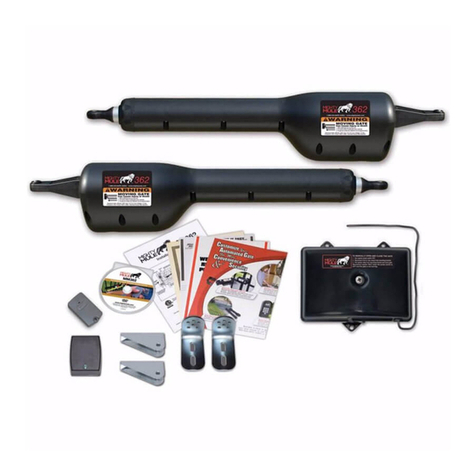
Mighty Mule
Mighty Mule MM362-D installation manual

Chamberlain
Chamberlain Swing GATE Installation and operation instructions
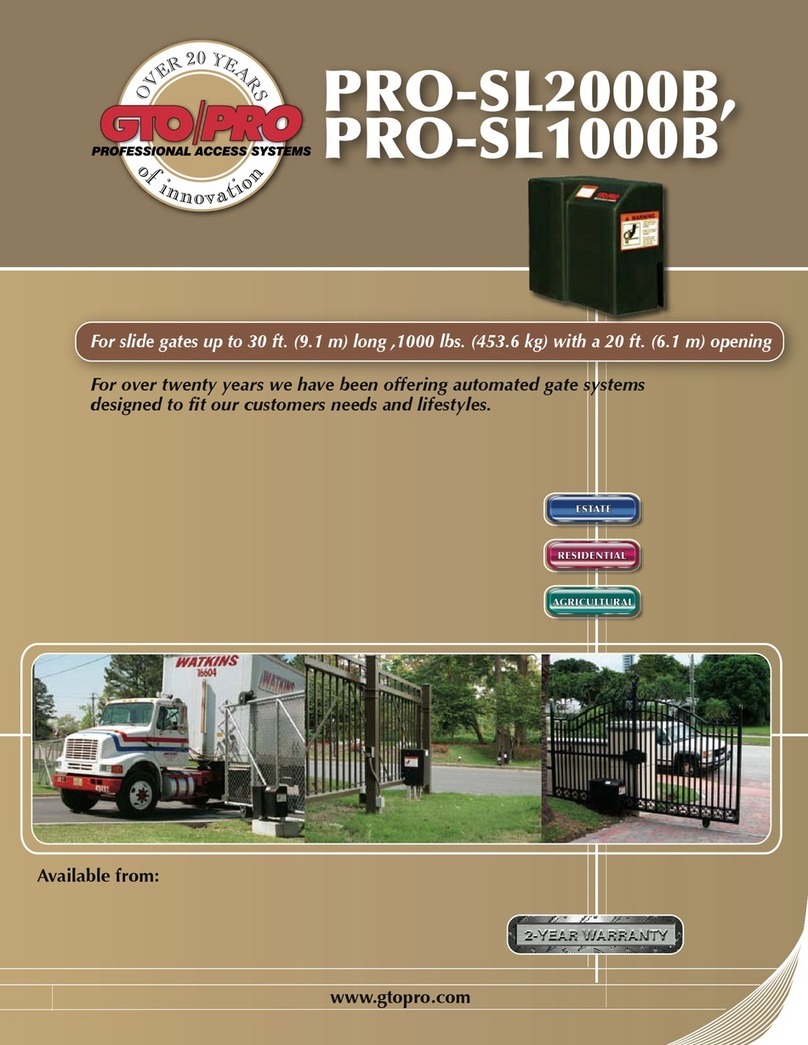
GTO
GTO PRO SL-1000B brochure
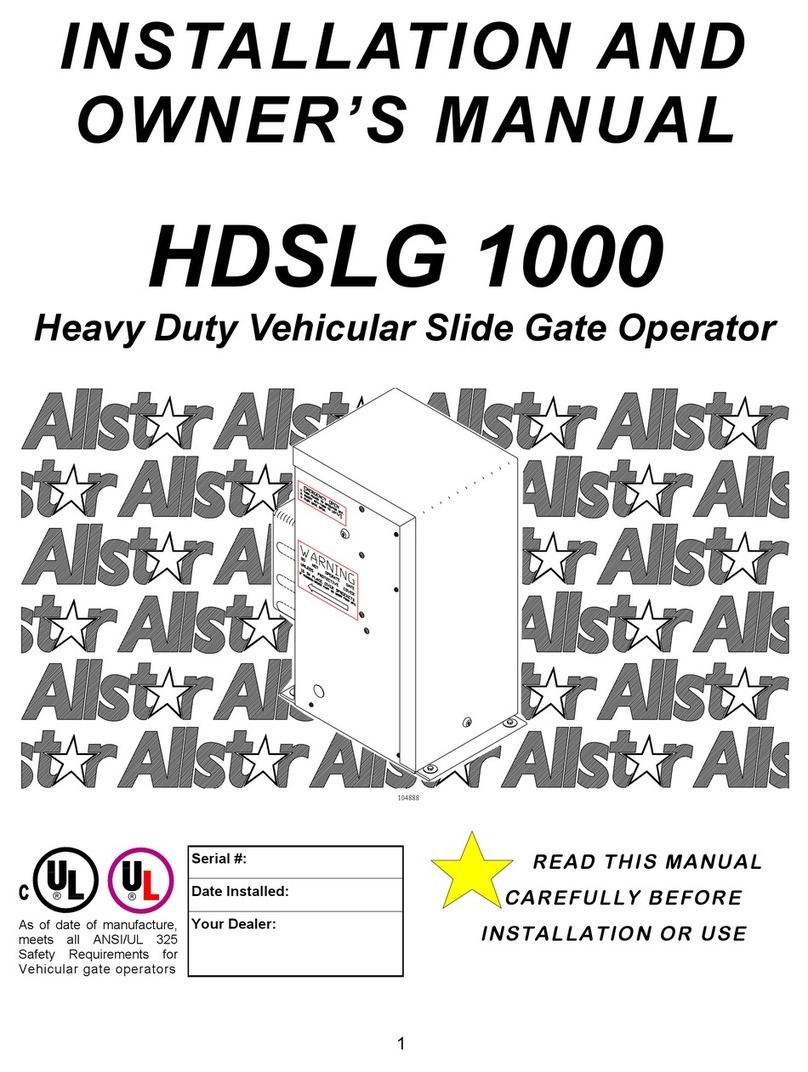
Allstar
Allstar HDSLG 1000 Installation and owner's manual

Chamberlain
Chamberlain WGO200 instructions
